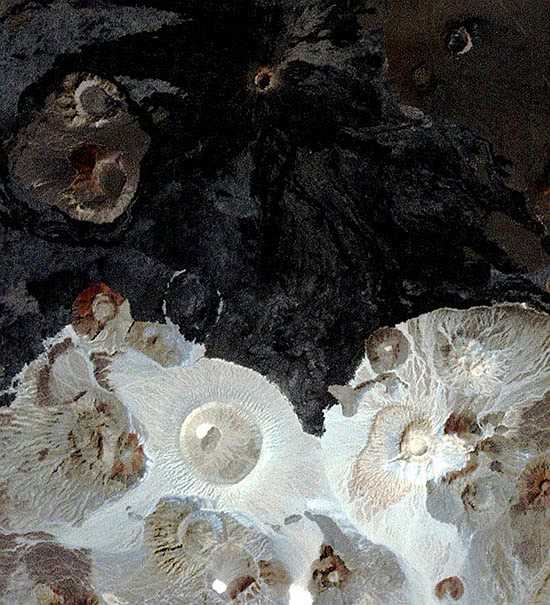 |
©2005 by John and Susy Pint, Updated Sept. 10, 2013
Photos by John & Susy Pint unless otherwise indicated
The Black and White volcanoes of Saudi Arabia deserve a high place on the list of the world’s most spectacular natural wonders, but few people have ever heard of them and very, very few indeed have ever laid eyes upon them.
In this aerial photo, however, you can easily spot the two white volcanoes, standing side by side, surrounded by Harrat Khaybar, a vast ocean of jagged lava located in western Saudi Arabia, north of Medina. Jebel (also spelled Jabal) Abyad is the one on the right and at 2093 meters, is the highest volcano in the Khaybar lava field. It is a dome of rare white-to-cream-colored lava that was squeezed up out of the bowels of the earth like toothpaste. This is a place where you certainly won't find people nearby for several thousand feet if not miles.
Just west of it, on the left, shaped like a giant doughnut the color of French Vanilla ice cream, lies Bayda, an ash cone 1913 meters high, which was formed by an explosive eruption of gas beneath the molten rock. The words abyad and bayda both mean white in Arabic and are the masculine and feminine forms of the adjective, perhaps reflecting early viewers’ interpretations of their shapes. Both are mainly composed of a rare, beige lava or ash known as comendite.
In stark contrast, only two kilometers to the north, a third volcano rises 2022 meters into the air. Jebel Qidr, as graceful and symmetrical as Mount Fuji, consists of hard, licorice-black basalt. Its last (and fairly recent) eruption spewed out a tar-colored flow that partially engulfs the two creamy-white volcanoes, earning Qidr the nickname “The Black Widow” as she seems to have been caught in the act of ensnaring her neighbors. The line of demarcation is so abrupt, you can actually stand with one foot on Qidr’s brittle, black basalt and the other in Bayda’s powdery white comendite.
We first heard of this unique place from our friend Patrick Pierard, a French explorer who seems to know every ancient well and dam in the country better than the Bedouin. Each time Patrick would mention the Black and White Volcanoes, he would wax poetic: “Ah, the majestic landscape, mon Dieu! The lovely sunlight bathing the black and white lavas and augmenting their startling contrast—incroyable!
Well, after listening to numerous descriptions like that, we were determined to visit this unique site before leaving the kingdom and we were touched and overjoyed when members of Dhahran’s Traveling Naturalists agreed not only to include us in an expedition to the heart of Harrat Khaybar, but to add an extra day to the trip so we could hunt for lava-tube caves, which we knew had been spotted on the slopes of Jebel Qidr.
We arrived at Kasaybah Dam late in the afternoon, when the waning sun was painting its walls a golden hue. This is a big dam, 20 meters high and about 135 meters long, said to be over 1000 years old. If this is true, the dam is marvelously well preserved. The only reason it is no longer functioning is because an earthquake literally pulled it apart, leaving a gap through which a river runs when there’s been enough rain.
The dam is roughly triangular in cross section with small steps on both sides. These steps are not worn down or deteriorated in any way and you can walk right up the side of the dam if you don’t panic when experiencing the unbelievably steep angle. The top is flat and so wide that “two horsemen riding over might pass each other,” according to Doughty. The surface of the dam still retains a thick, protective, mortar-like coating that seems to resist wind, rain and sun admirably. We noticed tiny bits of charcoal in it which might facilitate dating it, but, of course, the coating may have been replaced frequently and may not indicate the age of the original construction.
John and Liz Weatherburn and party arrived the next morning, after driving all night and somehow had the energy to lead us off to the Khaybar gas station right on time. John had been to the Black and White volcanoes twice before and was leader of the expedition.
We were supposed to fill our tires with air at the gas station. Whereas driving on loose sand requires lowering the tire pressure to 15 lbs, exactly the opposite is required for driving on lava. The tires should be rock hard, exposing as little rubber as possible to the sharp and irregularly shaped basalt.
...When all the tires were as full as possible, we rumbled east out of the gas station and were soon lost in great clouds of white dust. An hour or so later, the dust ended and the lava began in earnest, a great undulating sheet of black, crisscrossed by tracks going off in every direction.
Around mid-day, one of the vehicles in our party, a Jeep, suffered a blowout. Considering the sort of terrain we were driving through, it’s amazing that this was the only blowout on the entire trip. It turned out to be a long gash on the side, the kind of hole you can’t seal with sticky liquids or inserts. Unfortunately, the Jeep owner had only one spare (all the rest of us carried a second spare). So, after changing tires, we proceeded very slowly!
Unfortunately, we proceeded right down into a place you could fairly name “The Gully from Hell.” This track twisted down a steep slope and was well sprinkled with razor-sharp rocks. Even worse, the track kept getting narrower and the turns kept getting tighter as we descended until I wondered whether this path was originally designed for a go-kart. We reached several points where we had to pass through huge rocks which were literally scraping our tires on both the left and the right. Susy would have to jump out at every turn and attempt to move rocks which were often heavier than she is. I was gnashing my teeth, my eyes glued to the ground.
At the bottom of the gully, we decided to camp and also to abandon the Jeep, for the chances of a second blowout were now exceedingly high...
At last we drove up and out of the hole we had been in and only minutes later we came upon a flat, easy track. “Ah, we’re finally back on the right route,” declared our guides, now admitting that the Gully from Hell had not been on the planned itinerary at all...
| ...Then, suddenly in the distance, we saw the shimmering,
creamy-white walls of Jebel Bayda, the white volcano. We were going to make it
after all!
|
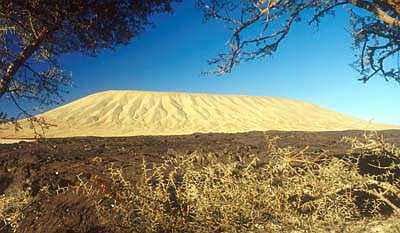 |
We approached the line of demarcation where the black lava of Jebel Qidr meets the beige lava of Jebel Bayda. The comendite looks white only from a great distance but actually represents a variety of colors from ashy to orange. Up close, it isn’t nearly as dramatic as the black lava, which has a fresh look as if it had been spewed out yesterday. In fact, our volcanologist friend, John Roobol, told us Qidr’s last eruption may have occurred as recently as 1880.
Walking on this lava is like being on the surface of a great pot of boiling, sputtering, splashing tar which somehow solidified in the blink of an eye, allowing us to experience with all of our senses, the essence of liquidity while roaming about on a solid surface. In some places, you find ropy lava which resembles long braids of twisted cord. Then, there are smooth, flat blocks, which seem to be floating on a roiling sea, like great chunks of a broken ice flow...
Our group’s original plan was to climb to the top of Jebel Qidr on day one, but so much of the day was already gone that only one member of the party (Greg Gregory) managed to reach the top, gaze inside Qidr’s deep maw and climb back down before sunset. On his way up, Greg noted numerous entrances to lava tubes. This coincided with reports and pictures we received from German explorers, who not only photographed several cave entrances but actually took advantage of the round, smooth tops of the lava tubes, using them as convenient “highways” for climbing the volcano.
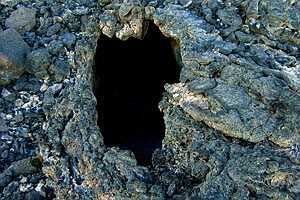 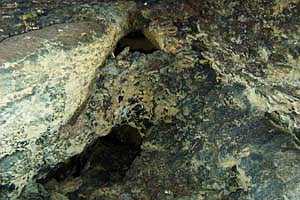
Two of the many lava tube entrances spotted by Greg Gregory as he ran up the side of Jebel Qidr (We're glad you stopped long enough to take pictures, Greg!) |
Next morning, we experienced something totally unexpected in Saudi Arabia: frost! Only after the sun came up did it melt off our car windows, at which time we were ready for the long climb to Bayda’s rim, walking up one of the steeply inclined “buttresses” of the giant ring, feeling as small as two fleas approaching an elephant.
But as we walked around the edge of the pie, we were rewarded with spectacular views of Qidr surrounded by its great flows of black lava and Abyad shimmering in the sunlight. Our campsite was a tiny speck, but easy to find because it was located in one of the few white inlets invading the great mass of black...
| ...We were surprised at how many other impressive cones and craters lay all
around us, many of them looking well worth a visit....
|
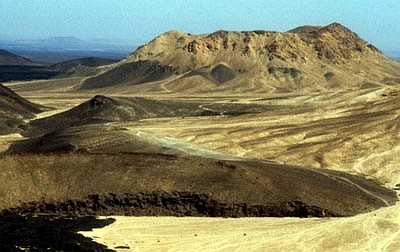 |
...In the distance, as far as the eye could see, there was the great bed of basalt which stretches from Medina to the Great Nafud: over 20,000 square kilometers of lava dotted with 46 basaltic shield volcanoes, over 300 scoria cones and 39 massive “whaleback” lava flows, named for their distinctive shape. It looked like a place where no one could possibly live, but later that evening we were to discover the ruins of just a few of the many walls built here by human beings in Neolithic times and almost completely surrounding Jebel Abyad.
Yes, the uninhabited landscape we were looking at was obviously once populated, not so surprising considering that we were only 65 kms due east of the ancient caravan trail which brought spices and incense from Yemen to Madain Saleh, Petra, Rome “and the world.” This trail, like all the others on the western side of the Arabian Peninsula, winds its way through 89,000 square kilometers of lava fields. Now, thanks to the studies we cavers carried out over the last four years, we know that most of these lava fields contain long and impressive caves, some of which were vital to man’s survival because they acted as reservoirs for the most precious substance in Arabia: water.
In point of fact, every lava tube we have found contains walls or structure built by human beings and artifacts are so common—even deep inside the lava tubes—that a visitor can simply pick them up, no digging required. Moreover, the still unexplored caves of Jebel Qidr lie exactly 50 kms south of a veritable treasury of Neolithic engravings located near Al Shuwaymis, art work that includes cattle and even lions, harking back to a very different climate in ancient times.
Between Al Shuwaymis and Jebel Qidr lie the famous whaleback flows. Originally, lava flowed beneath them and long strings of collapses viewed by Arabia’s famed volcanologists, Roobol and Camp (from helicopters) suggest that lava tubes up to 50 kilometers in length may still be found intact. (See Interview With a Volcanologist for more on Saudi Arabia's lava flows).
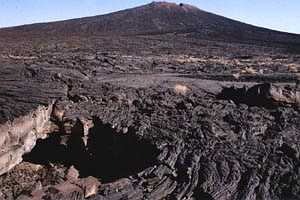 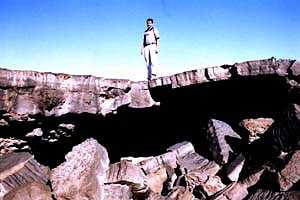
Two lava cave entrances at the foot of Jebel Qidr, found and photographed by German explorer Uwe Hoffman. |
What lies hidden in the recent lava tubes of Jebel Qidr and beneath the million-year-old whaleback flows just to the north? We now know for sure that ancient Man visited and used the lava caves located in this area where human beings first arrived from Africa and where much of humanity’s history took place. On our short visit to the Black and White volcanoes, we had no chance to approach even one of these caves, but we hope that eventually we will return to Harrat Khaybar, perhaps to participate in what could be one of the most important studies ever undertaken in the Middle East.
John and Susy Pint
|
|
BACK TO WWW.SAUDICAVES.COM HOMEPAGE